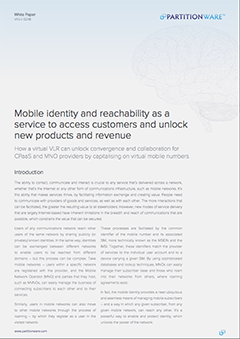Partitionware Virtual VLR and Auxiliary Roaming Solution
Virtual VLR and Auxiliary Roaming Solution
Network operators and service providers increasingly wish to offer more effective and efficient roaming and calling services to their customers. At the same time, subscribers often use different devices with different identities in different situations. A virtual VLR (vVLR) allows both needs to be met.
It enables network operators to provide extended roaming services to subscribers that use a separate roaming identity, while still receiving calls and SMS messages sent to their domestic number. This roaming identity can be an entirely separate SIM, or an additional IMSI on the same (multi-IMSI) SIM.
Easily manage multiple IMSI services
Key features:
- Allow service when domestic SIM does not enable roaming
- Reduce roaming costs by using specialist roaming SIM providers
- Deliver optimised, multi-IMSI roaming- centric services
- Network and roaming extension
- Enable OTT / GSM convergence
- Offer seamless VoIP / GSM services
A single identity for users
The vVLR enables operators to extend roaming to an OTT application or application server, enabling them to take advantage of a real GSM number for communication with mobile stations, and to provide a consistent public identity for those customers who wish to use multiple devices.
This approach to roaming removes the requirement to manage multiple individual roaming agreements, and allows the risk, costs and complexity of roaming traffic to be isolated from the operator’s domestic network and billing systems.
Extend the reach of OTT services
In addition, the vVLR allows GSM services (such as roaming and messaging) into non-GSM environments and to other kinds of devices. This allows convergence between GSM and VoIP calling, for example, as well as providing a means for OTT messaging services to interact with GSM end-points. This is a valuable capability that allows non-traditional and OTT service providers to extend their reach into GSM networks and interact with traditional GSM devices, rather than depend on a purely application based approach.
For outgoing services from the roaming SIM, the Auxiliary Roaming platform allows the presented CLI (Calling Line Identity) to be that of the domestic SIM - making the service seamless from the called party’s perspective. Data (GPRS/UMTS/HSPA) services can also be supported using APNs provided by the roaming SIM provider.
Standards-based for ease of integration
The Virtual VLR solution uses standard signalling to ease integration, supporting SS7 via TDM or IP links, reducing technical impact for the domestic operator. When the roaming SIM is active, the platform notifies the domestic HLR (Home Location Register) that the subscriber is roaming onto a sponsor/host operator’s network - which is in turn integrated into the roaming SIM provider’s network.
Using this technique, when incoming calls or SMS messages arrive at the domestic operator, they are automatically forwarded to the sponsor/host operator’s network using standard GSM roaming signalling. The Auxiliary Roaming platform provides a convenient, cost effective and reliable way to provide enhanced roaming to domestic customers with minimal technical impact.
Virtual VLR - Application Note.
Control of incoming calls and messages
Before the service is activated, the association between the domestic and roaming profiles (in terms of MSISDN and/or IMSI) is determined and authenticated. This could be carried out at point-of- sale, for example, or carrier out by the customer using a self-service facility using SMS or USSD, or a web- based application. This provides the Auxiliary Roaming platform with details of the domestic SIM - so it can take control of the incoming calls and messages as required.
When the roaming SIM is activated (either manually by the customer or by detection of network activity), the Auxiliary Roaming platform begins to send periodic LU (Location Update) messages to the domestic HLR, following normal GSM roaming procedures. Incoming calls and messages will then be automatically collected by the roaming SIM.
The platform operates as a virtual VLR/MSC from a roaming perspective - but instead of delivering calls and messages to an associated delivery network,
forwards them to the roaming SIM provider. When the domestic SIM is reactivated when the subscriber returns to their home network, the domestic HLR will send a CU (Cancel Location) message to the Auxiliary Roaming platform - and call and message routing will revert to the domestic SIM.
Two types of connectivity
Two types of connectivity are required between the domestic and host operator to support the platform. MAP/SCCP/C7 signalling is necessary to facilitate the roaming control - this is the same connectivity as would be required for a standard roaming agreement.
Second, connectivity must be in place to deliver the inbound calls from the GMSC of the domestic operator to the MSC which forms part of the Auxiliary Roaming platform. This connectivity can be either standard inter-carrier ISUP routes, or SIP-based peering can be established to reduce transit costs.







